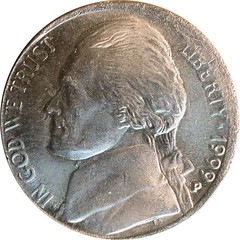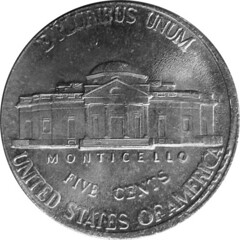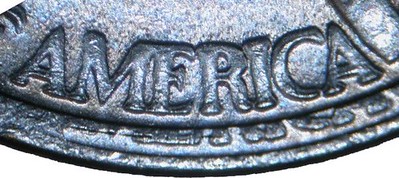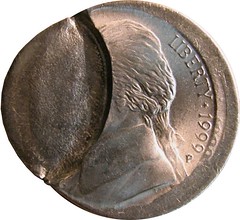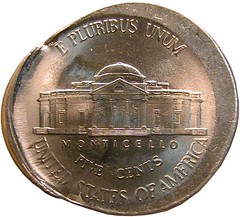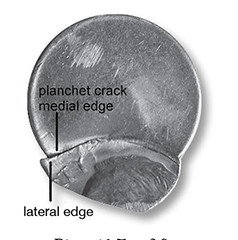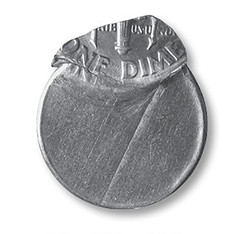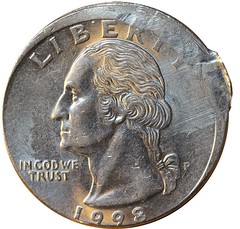
PREV ARTICLE
NEXT ARTICLE
FULL ISSUE
PREV FULL ISSUE
MIKE DIAMOND INTERVIEW, PART THREEHere's the third part of Greg Bennick's CONECA interview with collector and writer Mike Diamond, covering stutter strikes and other discoveries. Thanks again to Greg, ErrorScope Editor Allan Anderson, and CONECA for making this available here. -Editor Greg Bennick: Can you tell us what stutter strikes are, just for the uninformed among us. Mike Diamond: Sure. There are three types which I imagine I can call Type 1, Type 2, and Type 3. Type 1 involves a slightly off-center coin with one pole sitting on top of the collar. The hammer die comes down. The collar has to be a stiff collar. The hammer die comes down and makes an initial impression, then skips to one side and continues its downstroke to complete the strike, leaving a thin crescent of die-struck design lying outside the complete design. Greg Bennick: It would almost look like a double strike, except I'm assuming you only see that effect on one side of the coin.
Mike Diamond: Right! Always on the obverse side. And no grading service has ever correctly labeled these. They always label them as double strikes. In fact, no grading service uses the term Greg Bennick: And the stutter strike was one of your discoveries? Mike Diamond: Yeah. Greg Bennick: Amazing. How about Type 2 of the stutter strike? Mike Diamond: Type 2 involves a coin receiving a partial brockage or an indent, and that impact causes the rest of the coin to tip up and make early contact with the hammer die. As the hammer die continues its descent, it pushes that part of the coin out beyond the striking chamber and it completes its descent, completing the strike. So again, you end up with a thin crescent of die struck design lying beyond the normal design. Type 3 is kind of a wastebasket where a bent or a torn or some other irregular planchet causes the die to skip and leave again a slight sliver of design out beyond the normal design. A correction! In the printed interview with Mike Diamond, a photo of the reverse of the dime with the Type III stutter strike was not included. The photo showed the obverse but the stutter strike is on the reverse, and so, here are images of both sides of the coin. -Editor Greg Bennick: All of your discoveries aren't all printed in one place, are they? I know they are in Coin World, but I don't think they are available easily? How would someone find out about all of your work? Mike Diamond: I wrote up a lot of these in ErrorScope. But they've all been revisited in Coin World. I've been writing for Coin World since 2007. Greg Bennick: Given all of your discoveries, which to you are the most significant? I've read through your list of what you've discovered and it's fascinating. I'm just wondering which of those you think were the true eureka moments? Mike Diamond: Okay, I'll give you an example of one. Some of these take me years to figure out, because it requires collecting a sample. But die attrition errors, which of course no grading service is going to label, die attrition errors took me years to figure out because you're dealing with a design that's partly missing and replaced with a featureless crescent. Over time I accumulated more and more examples of it. It became clear to me that the edge of the hammer die was simply being worn away as it repeatedly contacted the beveled entrance of the collar. And so sometimes they are labeled as cuds. Sometimes they're mislabeled as misaligned dies. You'll see all sorts of misidentifications. So, it's always satisfying when I can figure out something that's been bugging me for years. There was a recent article on Trans Strike Damage. This is damage that occurs before, during, and after the strike. I haven't totally figured out all the details of it. I've only seen three examples of it. Two examples I only knew from photos. The third example I managed to purchase from Jon Sullivan, who basically listed it as a damaged broadstrike, which is what it sort of looks like. But clearly, some of the damage is post-strike, some of the damage is pre strike or intra-strike. But anyway, that purchase allowed me to at least characterize it as a form of damage that is continuous through the striking process as the coin is pinned between the dies and something is damaging it. 1998-P quarter with trans-strike damage on its obverse face (which was struck by the anvil die) Greg Bennick: Do you ever just see other people, who know less than you, attribute errors and you just shake your head silently and smile because you know so much more than they do about the minting process? (laughs) I can imagine that happening. Mike Diamond: I try to correct people's misconceptions. I check in on Joe Cronin's Facebook group. I check in and if somebody makes a mistake or an opinion needs to be elaborated on, I contribute my thoughts. I also contribute to the Coin Community error group. In fact, I made two posts today where people had misconstrued an error. The first one was a missing clad error, and everybody said it was a fake, and I immediately could tell it was genuine. Sometimes I'll pop my head in Coin Talk. I hosted a group for twenty years and then Yahoo! got rid of all its groups. So that was it for that little endeavor. Greg Bennick: What happened to the information that was on that group, which I remember as the Error Coin Information Exchange? Mike Diamond: It just vaporized. I decided not to download it because pretty much anything on there, ends up in my Coin World column. In fact, everything in ErrorScope has actually ended up in my Coin World column with additional information. Greg Bennick: Tell me about error-ref.com. I think people would love to know about it if they already don't. Mike Diamond: It's a resource on die varieties and errors, all kinds of errors, die varieties, planchet errors, striking errors. It's supposed to be a complete resource though it is really not complete. There's a twenty-five or so page checklist of every type of die variety and essentially every type of error that I know of. I update it every year or two. The types of errors that are not well covered in standard references are what I tend to focus on as far as creating a full page for them.
More of Greg's error interviews can be found in previous issues of Errorscope magazine.
For more information on the Combined Organization of Error Collectors of America (CONECA), see:
To read the earlier E-Sylum articles, see:
Wayne Homren, Editor The Numismatic Bibliomania Society is a non-profit organization promoting numismatic literature. See our web site at coinbooks.org. To submit items for publication in The E-Sylum, write to the Editor at this address: whomren@gmail.com To subscribe go to: https://my.binhost.com/lists/listinfo/esylum All Rights Reserved. NBS Home Page Contact the NBS webmaster 
|
